INDESTRUCTIBLE, INSATIABLE, INDESCRIBABLE… well, maybe not that last one? No, this blob isn’t the drive-in movie that chronicles a Pepto-pink alien sludge bent on wreaking havoc in a small town where Steve McQueen lives. That’s the good news. The bad news? The blob we’re discussing this week is both indestructible and insatiable, but we’re going to describe it, and the issues it causes with regards to the ecosystems and supply of fish as best we can.
The Pacific Ocean Blob was created by warmer than normal water temperatures in the North Pacific Ocean. That killed off krill and the other food supplies for the baby salmon and other species. Global warming, whether human caused or otherwise, has resulted in 17 of the last 18 hottest years ever recorded since the mid 1800s, between 2000 and 2017. Ocean conditions off of most of the West Coast are now returning toward average temperatures and the strong El Nino conditions have started to decline.
That has resulted in an improvement of the food supply for marine mammals and sea birds. Plankton species and krill, which are the foundation of the ecosystem, have recovered back to abundance. This essential link is critical to improve the growth and survival of salmon and other Alaskan fin fish species. I would not expect the run of 2019 to be back to average, but we should start to see more fish available. They may be smaller, like those caught in the 2017 season, but if things continue in a positive direction, there should be more breadth to the available salmon areas and returns.
Fish that enter the ocean this year with the gradually improving conditions will be returning in 2021-2022. The ocean is a flourishing ecosystem but is only as viable as its weakest link.




